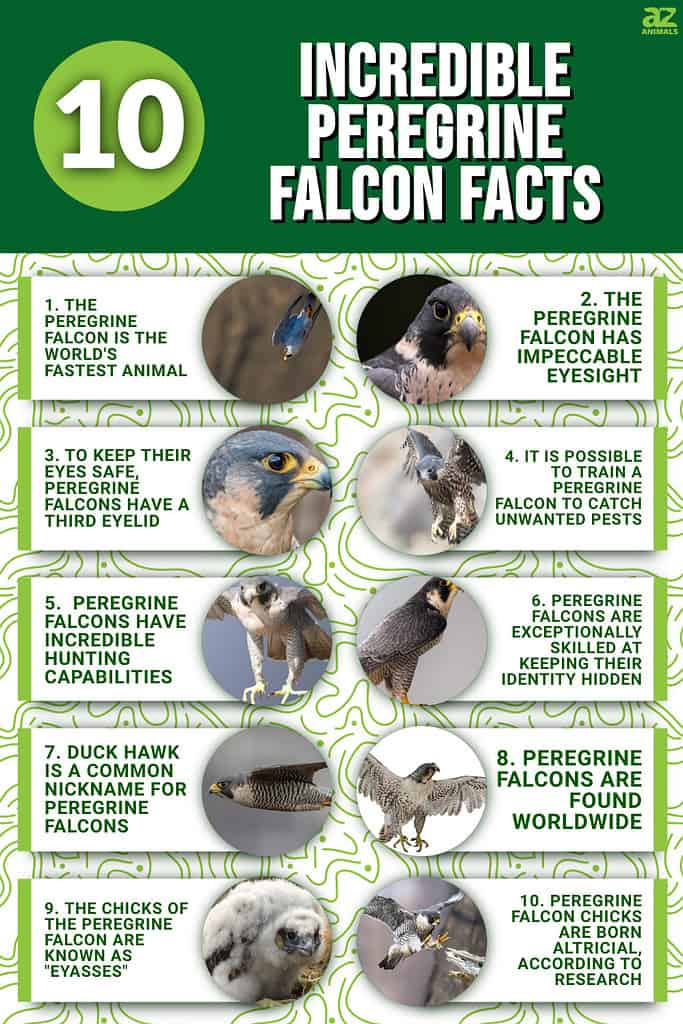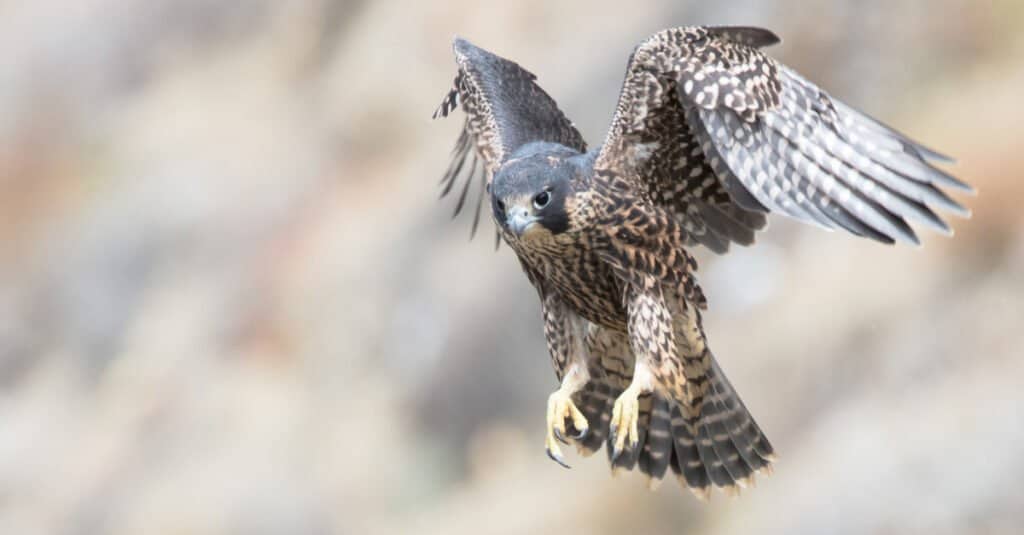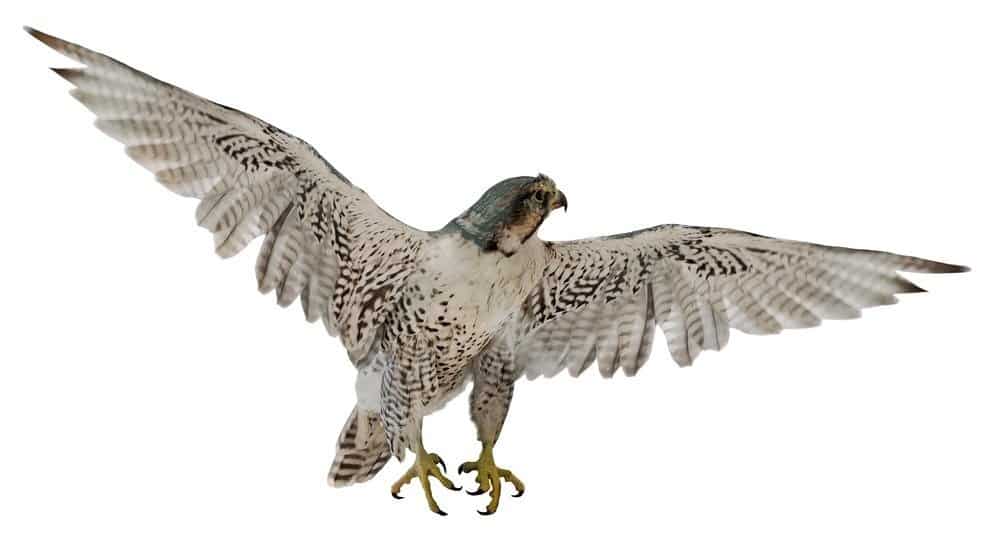Peregrine falcons are amazing birds with a unique appearance. They have a black head, white spots on the neck, a blue-gray back, rusty buff underparts, and thin black or brown barring. Their wings are dark to light brown with lighter edges. When in flight, the falcon’s underwings appear grey with black bars, and the feather tips are black. They have long black talons to grasp onto their prey as they swoop down from great heights! Interested in learning more? This post has 10 incredible peregrine falcon facts, along with photographs!

1. The Peregrine Falcon Is the World’s Fastest Animal

The Peregrine falcon has an unmatchable speed of 242mph!
©Harry Collins Photography/Shutterstock.com
Peregrine falcons are known for their high-speed dives. They can glide far without flapping their wings. Peregrine falcon dives quickly when flying. When they stoop, they may reach 200 to 240 mph. They’re the fastest on land, sea, and air. Wow!
2. The Peregrine Falcon Has Impeccable Eyesight

The peregrine falcon has impeccable eyesight.
©Chris Hill/Shutterstock.com
The peregrine falcon’s excellent eyesight is one of the species’ most recognizable traits. This falcon’s vision is eight times better than that of a person at distances up to 1.86 miles! The ability of a falcon to easily observe its prey before diving in and capturing it makes the falcon an effective hunter.
3. To Keep Their Eyes Safe, Peregrine Falcons Have A Third Eyelid

Peregrines have a third eyelid.
©iStock.com/RamonCarretero
During dives, the peregrine falcon’s third eyelid serves as a shield for its eyes. In protection of the eye, the eyelid is also known as the nictitating membrane. Even though the conjunctiva membrane spreads tears throughout the layer of the cornea, it does not impair vision during diving.
4. It Is Possible To Train A Peregrine Falcon To Catch Unwanted Pests

The peregrine falcon can be trained to catch certain pests.
©TPCImagery – Mike Jackson/Shutterstock.com
The peregrine falcon is the fastest creature on the planet. In addition to their hunting abilities, they can also be taught to capture pests that threaten crops, such as rats. Training them, however, will take a significant amount of the instructor’s time and patience.
5. Peregrine Falcons Have Incredible Hunting Capabilities

Peregrine falcons are excellent hunters.
©Sally Wallis/Shutterstock.com
Among falconry’s most well-known birds is the peregrine falcon, which is used for hunting. In the animal realm, the peregrine falcon is a great hunter. The stoop of these birds is one of the most spectacular flying patterns, in which they descend fast towards their prey and then pull back just before impacting it. An attack occurs as the prey is falling or pounced upon. Pigeons, ducks, geese, and shorebirds are among peregrine falcons’ favorite targets, but they’ll attack any bird they can find.
6. Peregrine Falcons Are Exceptionally Skilled At Keeping Their Identity Hidden

A peregrine falcon can camouflage well and make itself look like a small bird.
©iStock.com/hstiver
The capacity of the peregrine to camouflage in with their environment is often overlooked. However, If they tuck their wings into their back, they can reduce to the proportions of a little bird, like a pigeon. Because of this, they can remain undetected while perched on electricity lines or other structures.
7. Duck Hawk Is a Common Nickname for Peregrine Falcons

Peregrine falcon is also called duck hawk.
©Harry Collins Photography/Shutterstock.com
Although its official name in the scientific community is the “Duck Peregrine Falcon,” they are more frequently known as “Duck Hawks.” This is because of its preference for living in marshy environments and its propensity of traveling in groups with migrating ducks.
8. Peregrine Falcons Are Found Worldwide

The peregrine falcon has a massive range.
©Potapov Alexander/Shutterstock.com
As stealthy as they are, the peregrine falcon is a common bird found worldwide. Falco peregrinus means “wandering falcon,” which perfectly describes these migratory peregrines who cover a lot of ground. North America has them more than any other continent. Hawaii and Alaska also have peregrine falcons. One-third of peregrine falcons live on remote islands like Africa‘s Gough Island or Baja California’s Guadalupe Island. They’ve even been spotted in caves and at 4,000 feet!
9. The Chicks of the Peregrine Falcon Are Known As “Eyasses”

Peregrine falcon chicks are referred to as eyasses.
©Fufachew Ivan Andreevich/Shutterstock.com
Peregrine falcon “eyasses” are the young birds of the species. There are usually three to four young in a peregrine falcon’s nest. Their eggs, which seem to be relatively smaller than chicken eggs, are speckled with a dark reddish-brown hue. The female largely controls the 33-day incubation period. Up until fledging, these chicks increase about an inch in length every week, and then they leave the nest with all their feathers out!
10. Peregrine Falcon Chicks Are Born Altricial, According To Research

Peregrine falcons must look after their chicks because they are helpless in their nests.
©Harry Collins Photography/Shutterstock.com
Peregrine falcon chicks are born “wet,” nascent, and helpless. Hence they are known as altricial chicks. After roughly a week of age, peregrine falcon chicks can see for the first time. Approximately a month after they can hunt, they will be ready to leave the nest and begin their lives as a family.
The photo featured at the top of this post is © Harry Collins Photography/Shutterstock.com
Thank you for reading! Have some feedback for us? Contact the AZ Animals editorial team.






